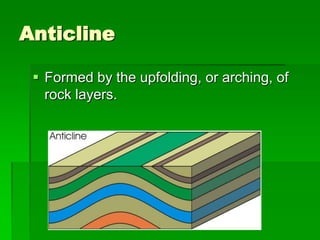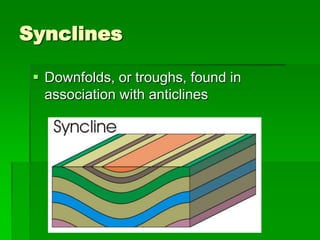Ppt 11.1 earth
- 1. Earth Science11.1 Rock Deformation
- 2. StressThe force per unit area acting on a solid.
- 3. StrainThe change in shape or volume of a body of rock as a result of stress.
- 4. AnticlineFormed by the upfolding, or arching, of rock layers.
- 5. SynclinesDownfolds, or troughs, found in association with anticlines
- 6. MonoclinesLarge, step-like folds in otherwise horizontal sedimentary strata
- 7. Normal faultOccurs when the hanging wall block moves relative to the footwall block
- 8. Reverse faultA fault in which the hanging wall block moves up relative to the footwall block.
- 9. Thrust faultReverse faults with dips of less than 45 degrees
- 10. Strike-slip faultFaults in which the movement is parallel to the trend or strike, of the fault surface
- 11. What You Should Know…The factors that influence the strength of a rock and how it will deform include temperature, confining pressure, rock type, and time.Rocks deform permanently in two ways: brittle deformation and ductile formation.
- 12. More 411 On DeformationForces that are unable to deform rock when first applied may cause rock to flow if the force is maintained over a long period of time.The three types of stresses that rocks commonly undergo are tensional stress, compressional stress, and shear stress.
- 13. Even More InformationThe three main types of folds are anticlines, synclines, and monoclines.The major types of faults are normal faults, reverse faults, thrust faults, and strike-slip faults.












